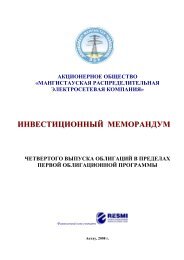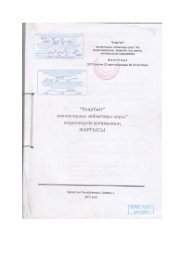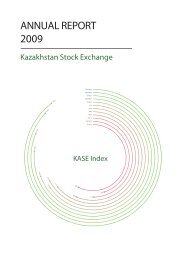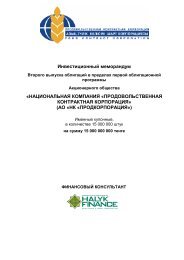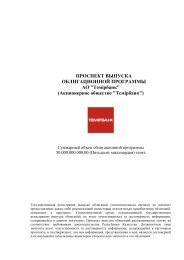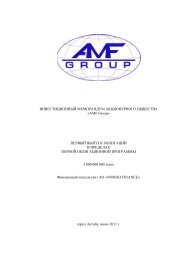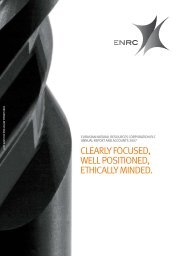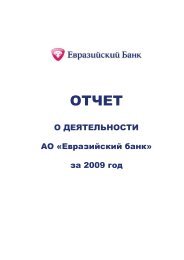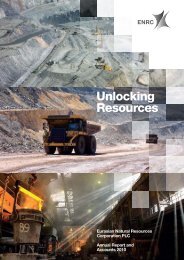JPMorgan - KASE
JPMorgan - KASE
JPMorgan - KASE
Create successful ePaper yourself
Turn your PDF publications into a flip-book with our unique Google optimized e-Paper software.
Estimated Reserves and Present Worth Values Before Income Tax on a Constant Price Basis<br />
Estimated Present Worth Values<br />
Estimated Reserves<br />
Before Income Tax (3)(4)(5)<br />
Oil Natural Gas Discounted at<br />
Gross (1) Net (2) Gross (1) Net (2) Undiscounted 10% 15% 20%<br />
(Mbbls) (Bcf) (in 000’s)<br />
Proved developed<br />
producing (6) ......... 242,811 223,996 0 0 $1,504,426 $1,101,900 $978,169 $882,500<br />
Proved undeveloped (6) . . 102,371 93,956 33 30 479,298 315,245 258,511 213,532<br />
Total proved (6) ......... 345,182 317,952 33 30 1,983,724 1,417,145 1,236,680 1,096,032<br />
Probable reserves (6) ..... 162,796 150,990 17 16 1,104,148 630,663 506,973 419,107<br />
Proved plus probable<br />
unrisked (7) ........... 507,978 468,942 50 46 3,087,872 2,047,808 1,743,653 1,515,139<br />
Reduction for risk (7) ..... (81,398) (75,495) (9) (8) (552,074) (315,331) (253,486) (209,554)<br />
Total proven plus<br />
probable risked ...... 426,580 393,447 41 38 2,535,798 1,732,477 1,490,167 1,305,585<br />
(1) Gross reserves are defined as the aggregate of our working interest share of reserves before deductions of royalties payable<br />
to others.<br />
(2) Net reserves are gross reserves less all royalties payable to others.<br />
(3) “Estimated present worth values before income tax” is the estimated present worth values of the future cash flows derived<br />
from the sale of our estimated reserves after giving effect to estimated capital expenditures, royalties and operating and<br />
marketing expenses, but excluding any withholding taxes or other taxes on earnings. These estimates take account of<br />
Kazakhstan general and administrative expenses. The values do not necessarily represent fair market value.<br />
(4) Our share of capital expenditures is estimated on an escalated price basis at approximately $548 million, approximately $525<br />
million on a constant price basis, over the future life of the fields including development of 100% of the probable reserves.<br />
This amount includes projected expenditures of $184 million, $143 million and $64 million, respectively, for the 2002, 2003<br />
and 2004 calendar years on an escalated price basis and $185 million, $140 million and $61 million, respectively, for the 2002,<br />
2003 and 2004 calendar years on a constant price basis.<br />
(5) The constant price basis utilized by McDaniel assumes the continuance of current laws and regulations. In preparing its<br />
constant price basis report, McDaniel used $10.50/Bbl of crude oil, the average price we received for oil in 2001 and used<br />
$1.05/Mcf of natural gas and assumed we would have received the same price had our other fields been producing.<br />
(6) “Proved reserves” are those reserves estimated as recoverable under current technology and existing economic conditions,<br />
from that portion of a reservoir which can be reasonably evaluated as economically productive on the basis of analysis of<br />
drilling, geological, geophysical and engineering data, including the reserves to be obtained by enhanced recovery processes<br />
demonstrated to be economic and technically successful in the subject reservoir.<br />
“Proved developed producing reserves” are those proved reserves that are actually in production, or if not producing, that<br />
could be recovered from existing wells or facilities and where the reasons for the current non-producing status is the choice<br />
of the owner rather than the lack of markets or some other reason. An illustration of such a situation is where a well or zone<br />
is capable but is shut-in because its deliverability is not required to meet contract commitments. Reserves assigned to nonproducing<br />
zones in producing wells were classified as producing if the reserve quantities were estimated to be minor relative<br />
to our reserves in the area.<br />
“Proved undeveloped reserves” are those reserves expected to be recovered from new wells on undrilled acreage or from<br />
existing wells where a relatively major capital expenditure will be required.<br />
“Probable reserves” are those reserves which analysis of drilling, geological, geophysical and engineering data does not<br />
demonstrate to be proved under current technology and existing economic conditions, but where such analysis suggests the<br />
likelihood of their existence and future recovery. Probable additional reserves to be obtained by the application of enhanced<br />
recovery processes will be the increased recovery over and above that estimated in the proved category which can be<br />
realistically estimated for the pool on the basis of enhanced recovery processes which can be reasonably expected to be<br />
instituted in the future.<br />
(7) Probable reserves have been reduced by us by 50% to account for risk. McDaniel, in the McDaniel Reports, did not risk-adjust<br />
the probable reserves, but reduced the estimated present value of future cash flows generated therefrom by 50% to account<br />
for risk.<br />
(8) The escalated price basis assumes the continuance of current laws and regulations. The escalated product prices forecast in<br />
the McDaniel Reports represent McDaniel’s opinion of future North American crude oil, natural gas and natural gas product<br />
prices as at January 1, 2002 and our opinion of the price differentials between North American reference prices and prices<br />
received in Kazakhstan. Political and economic uncertainties in Kazakhstan and internationally may result in prices different<br />
from those used in the McDaniel Reports. The prices and escalation factors used in this escalated price basis are as follows:<br />
65




